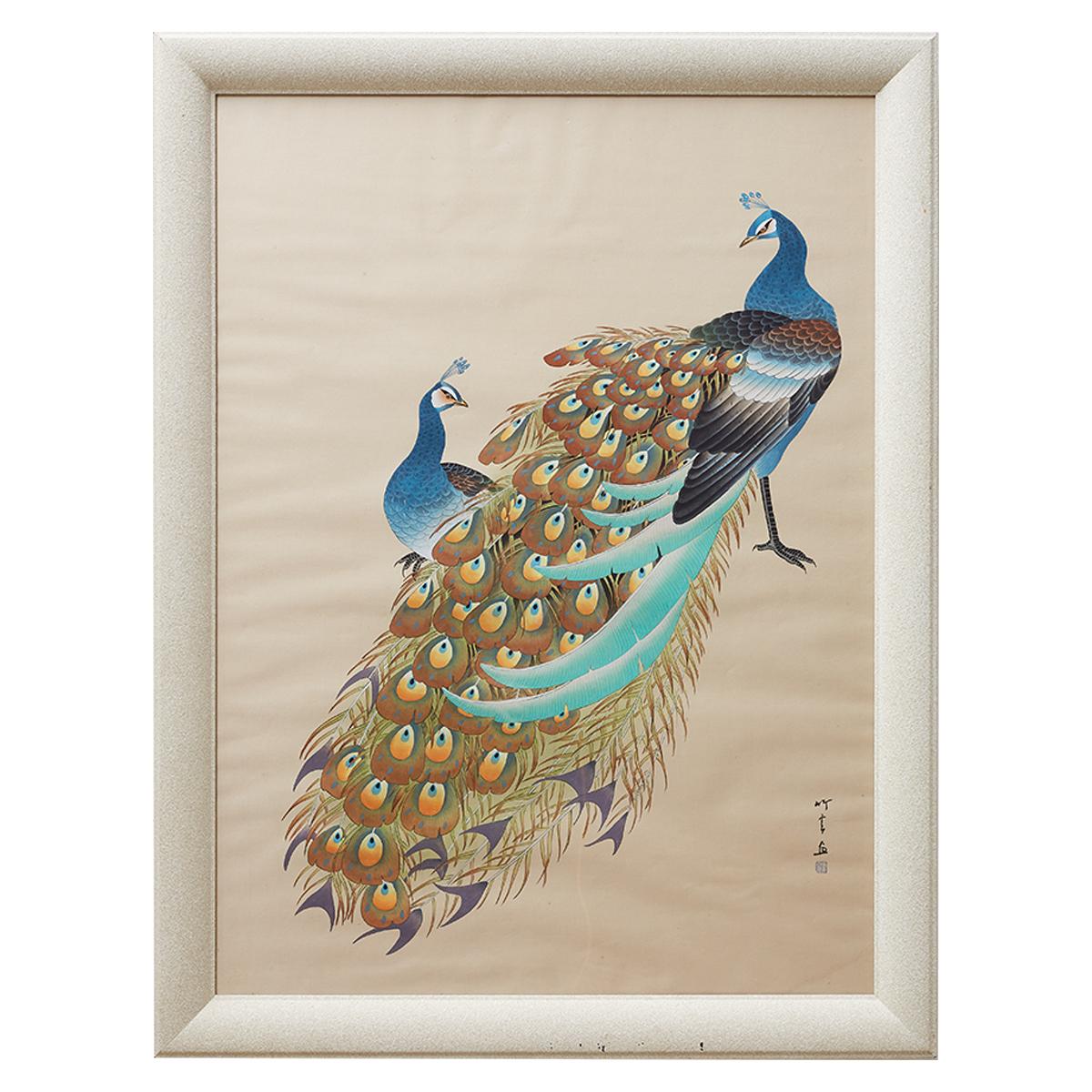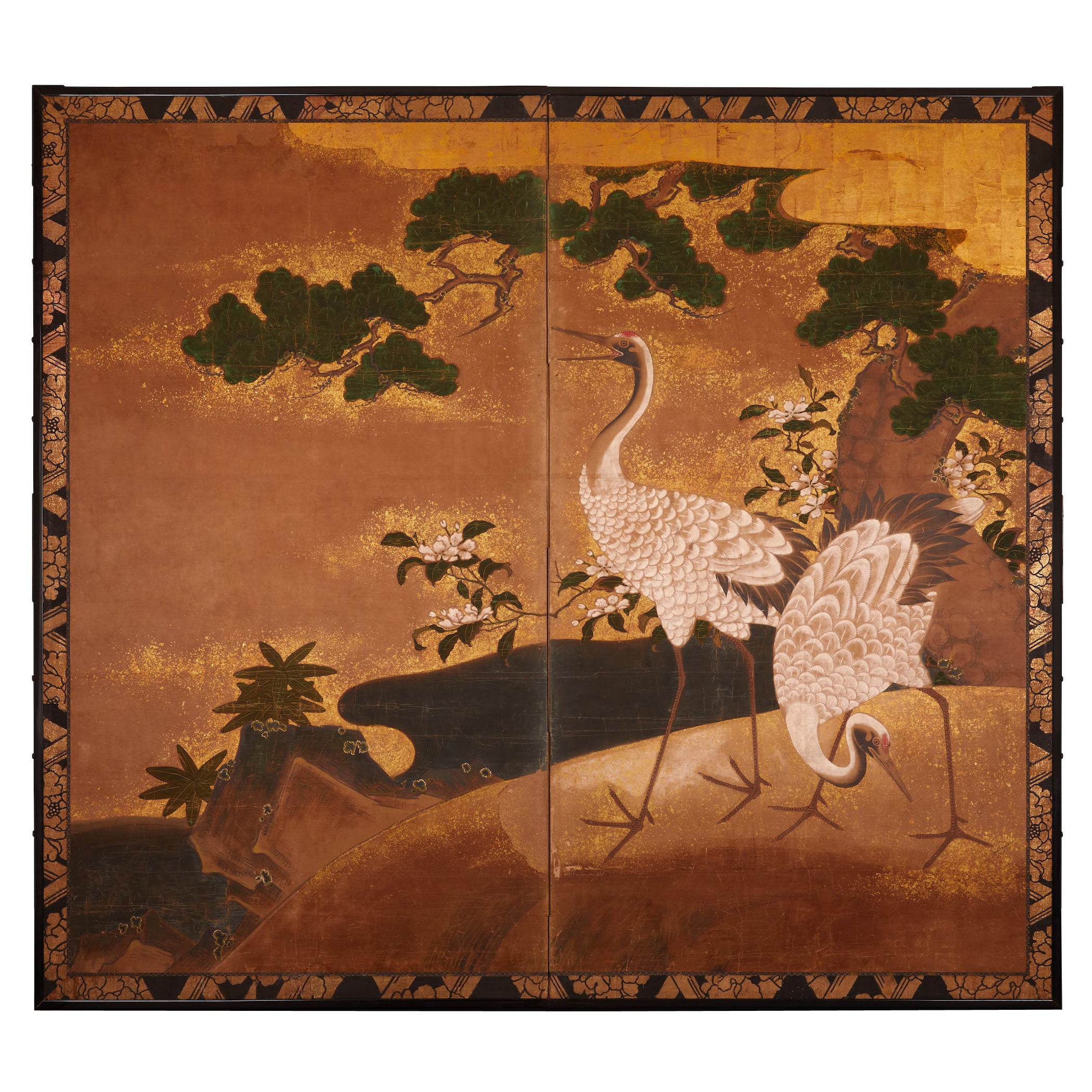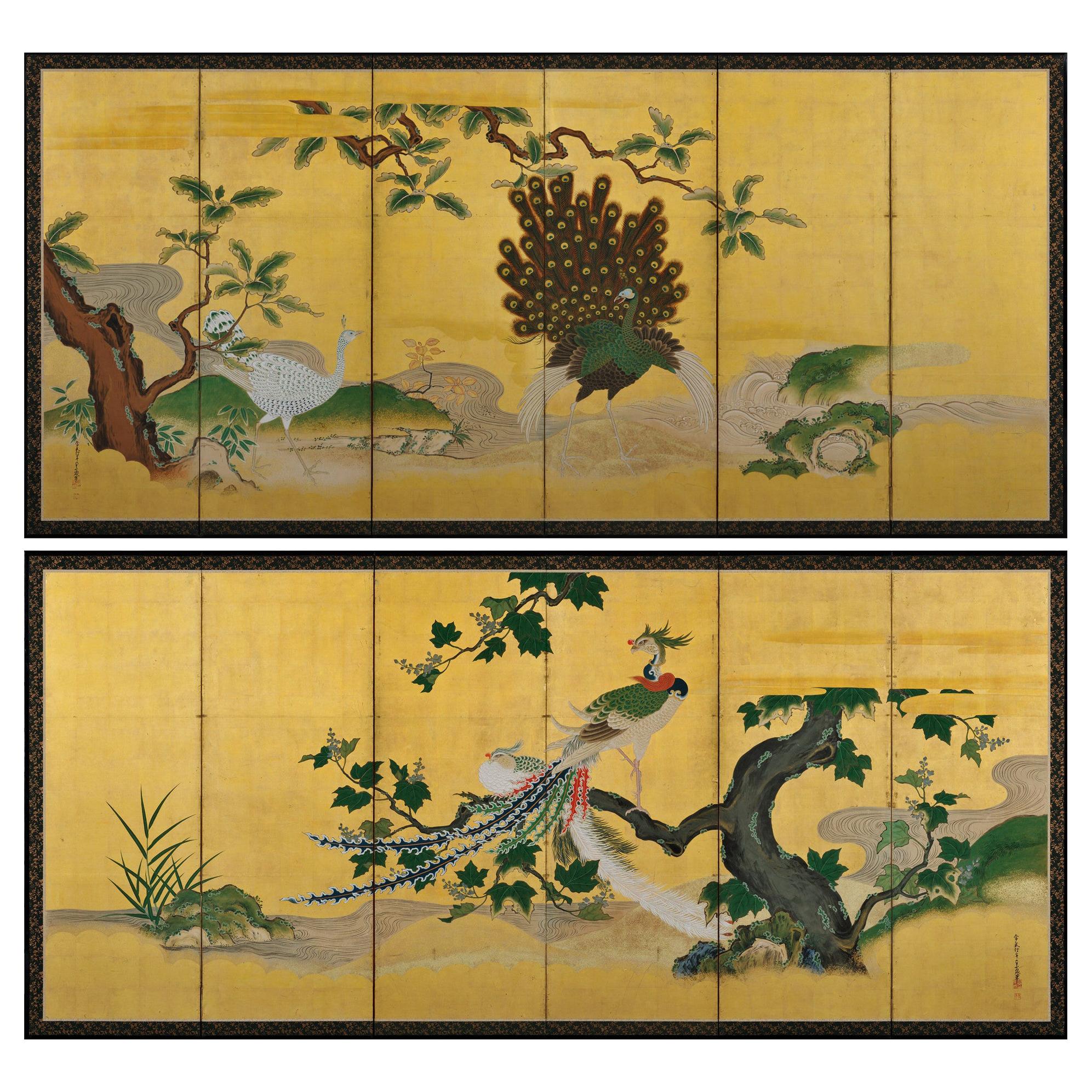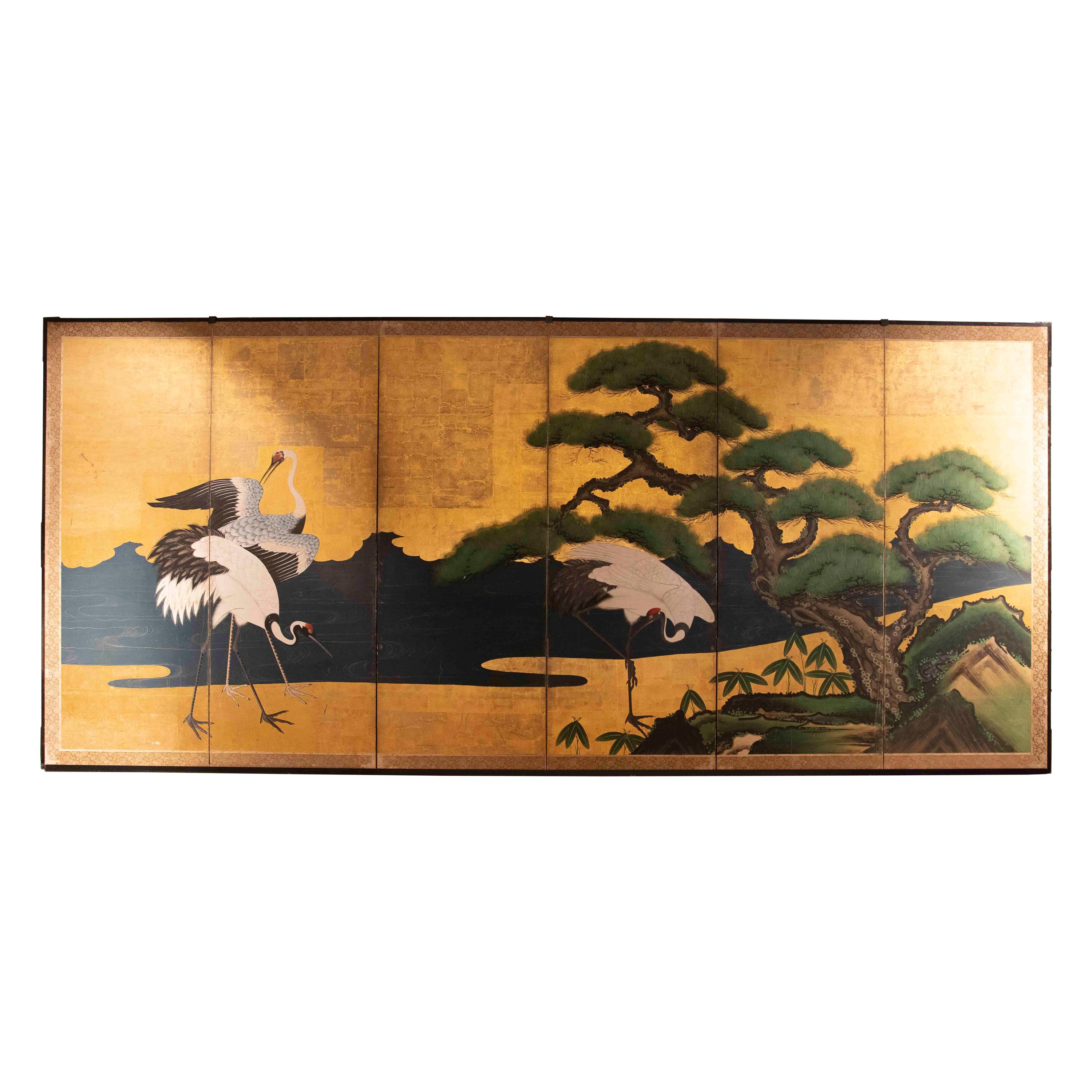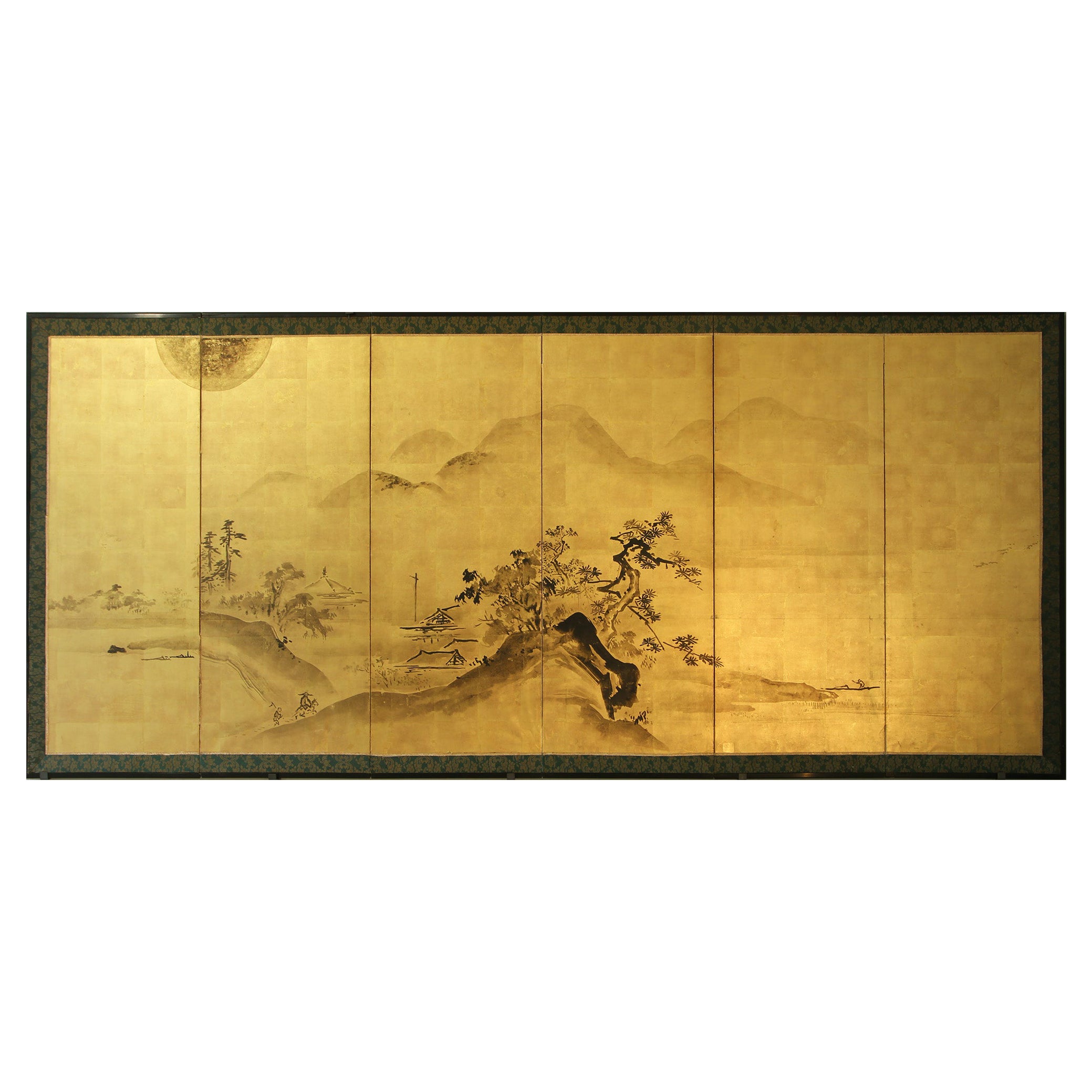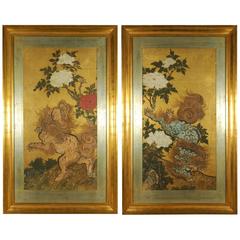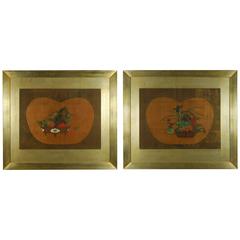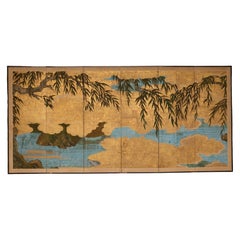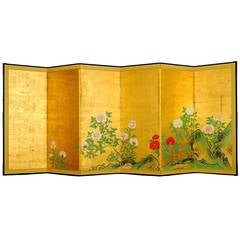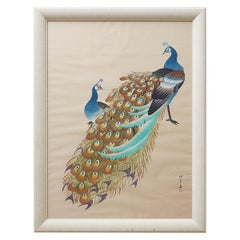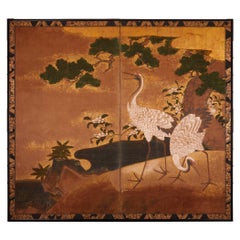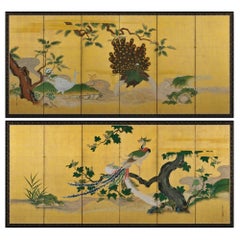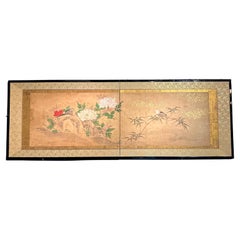Items Similar to Pair of Japanese Screens: Ink paintings of peacocks on gold leaf by Imao Keinen
Want more images or videos?
Request additional images or videos from the seller
1 of 11
Pair of Japanese Screens: Ink paintings of peacocks on gold leaf by Imao Keinen
$30,000per set
£22,775.49per set
€26,050.30per set
CA$41,914.35per set
A$46,617.91per set
CHF 24,342.42per set
MX$567,290.34per set
NOK 310,889.88per set
SEK 291,559.86per set
DKK 194,423.37per set
Shipping
Retrieving quote...The 1stDibs Promise:
Authenticity Guarantee,
Money-Back Guarantee,
24-Hour Cancellation
About the Item
A pair of screens by Imao Keinen featuring peacocks painted in ink on gold leaf. Lacquered wood frame, brocade border, incised copper hardware.
Dimensions: H 175cm x W 352cm
Biography of Imao Keinen (1845-1924).
Imao Keinen was born in Kyoto in 1845, the fifth son of Imao Inosuke.
He first studied Ukiyo-e style with Umegawa Tōkyo, later he became a pupil of Suzuki Hyakunen, studying painting and calligraphy. He also studied other styles than those of his masters, which resulted in an eclectic style. He combined his part-time study and work in his father’s business with painting in the evenings. In 1868, after the family business was lost in the upheaval marking the end of the Tokugawa period, he began his own studio. At this time Nanga painting was at its summit and many artists turned to Nanga, but Keinen remained true to his own style. At the same time he worked as a design adviser for a textile company to make a living.
In 1888 he became professor at the Kyoto Prefectural School of Painting. Keinen was a frequent exhibitor and prize-winner at many shows and exhibitions in Japan and in Paris and an important figure in Kyoto art circles. In 1904 he became a member of the Art Committee of the Imperial Household, and in 1907 a juror for the first Bunten. In 1919 he became a member of the Imperial Art Academy. In this period of his life he was probably the most famous painter of his time.
His recurring themes are flowers, birds and landscapes. He refrained from figure-painting.
Imao Keinen had many pupils, some of the best known are his son Imao Keishō (1902-1993), Konoshima Ōkoku (1877-1938), Ueda Banshū, Kobayashi Gokyō and Shiba Kaisen. He died in 1924.
References:
Araki, Tsune (ed), Dai Nihon shôga meika taikan, Tokyo 1975 (1934), p.2049
Morioka, Michiyo and Paul Berry, Modern Masters of Kyoto, Seattle 1999, pp. 122-125
Roberts, Laurance P., A Dictionary of Japanese Artists, New York, 1976, p. 53.
- Creator:Imao Keinen (Artist)
- Dimensions:Height: 69.3 in (176 cm)Width: 128.35 in (326 cm)Depth: 7.88 in (20 cm)
- Sold As:Set of 2
- Style:Meiji (Of the Period)
- Materials and Techniques:
- Place of Origin:
- Period:
- Date of Manufacture:Unknown
- Condition:
- Seller Location:Prahran, AU
- Reference Number:Seller: JS77-Pair of Peacock screens1stDibs: LU125622195982
About the Seller
5.0
Vetted Professional Seller
Every seller passes strict standards for authenticity and reliability
Established in 1979
1stDibs seller since 2015
81 sales on 1stDibs
- ShippingRetrieving quote...Shipping from: Prahran, Australia
- Return Policy
Authenticity Guarantee
In the unlikely event there’s an issue with an item’s authenticity, contact us within 1 year for a full refund. DetailsMoney-Back Guarantee
If your item is not as described, is damaged in transit, or does not arrive, contact us within 7 days for a full refund. Details24-Hour Cancellation
You have a 24-hour grace period in which to reconsider your purchase, with no questions asked.Vetted Professional Sellers
Our world-class sellers must adhere to strict standards for service and quality, maintaining the integrity of our listings.Price-Match Guarantee
If you find that a seller listed the same item for a lower price elsewhere, we’ll match it.Trusted Global Delivery
Our best-in-class carrier network provides specialized shipping options worldwide, including custom delivery.More From This Seller
View AllPair of Antique Japanese Paintings of Karashishi, Edo Period, 18th Century
Located in Prahran, Victoria
A rare pair of antique Japanese Karashishi paintings in a landscape of rocks and peony flowers on gold leaf ground in fine handmade frames, Edo period, early 18th century. The Karash...
Category
Antique Early 18th Century Japanese Edo Paintings and Screens
Materials
Gold Leaf
Pair of Antique Japanese Flower Paintings by Yanagisawa Kien, circa 18th Century
By Yanagisawa Kien
Located in Prahran, Victoria
Pair of antique Japanese Nagasaki School paintings by Yanagisawa Kien (1704-1758), depicting classical ikebana flower arrangements. Each painted on silk in mineral pigments and beari...
Category
Antique Mid-18th Century Japanese Edo Paintings and Screens
Materials
Silk
Japanese antique screen - EDO period - Willow over a stream
Located in Prahran, Victoria
Antique Japanese 6 panel screen from the early Edo period (C1650). One of a pair (both available). This magnificent golden screen shows...
Category
Antique 1650s Japanese Edo Paintings and Screens
Materials
Gold Leaf
Antique Japanese Six-Panel Screen by Kano Chikanobu "Shushin"
Located in Prahran, Victoria
Late 17th century Kano school peony landscape screens. Both screens signed: Hogan Josen Fujiwara Chikanobu Hitsu - Kano Chikanobu (Shushin) (1660 - 1728...
Category
Antique Early 18th Century Japanese Edo Paintings and Screens
Materials
Gold Leaf
Large Antique Japanese Scroll Depicting a Nesting Crane, Taisho Period
Located in Prahran, Victoria
Large and exceptional Japanese hanging scroll with a realistically painted depiction of a nesting crane by Yoshifuji Yoshio, Taisho/Showa perio...
Category
Early 20th Century Japanese Taisho Paintings and Screens
Materials
Paper, Silk
Superb Japanese Black Lacquer Document Box with Gold Maki e Design, Meiji Period
Located in Prahran, Victoria
An antique black lacquer document box with an exquisitely detailed, finely wrought design from The Tale of the Genji depicted in gold maki e across the lid. Internally, the box is de...
Category
Early 20th Century Japanese Lacquer
Materials
Wood, Lacquer
$5,200 Sale Price
20% Off
You May Also Like
Japanese Showa Period Peacocks Painted on Silk
Located in Rio Vista, CA
Colorful Japanese ink and color on silk Showa painting of a pair of peacocks. Vivid colors and beautiful details with a signature and seal on right side bottom. Framed in a midcentur...
Category
20th Century Japanese Showa Paintings and Screens
Materials
Silk, Plexiglass, Paper, Wood
$1,440 Sale Price
20% Off
Japanese Two-Panel Screen: Cranes on Gold
Located in Hudson, NY
Early Kano School painting of pine trees overlooking two beautifully painted cranes and floral design in a natural setting by water’s edge. Mineral pig...
Category
Antique Late 18th Century Japanese Paintings and Screens
Materials
Gold, Gold Leaf
Japanese Screen Pair, circa 1730, Peacocks and Phoenix, Kano School
Located in Kyoto, JP
Phoenix and Peacocks.
A pair of six-panel Japanese folding screens by Tsunetake Yotei (n.d.)
First half of the 18th century.
The signature reads 67 year old Tsunetake.
The seals read:
-Tsunetake no in,
-Yotei,
-Seishin
Dimensions:
Each screen – H. 69” x W. 149” (176 cm x 378 cm)
A pair of Kano Grand Picture (Waga) screens depicting phoenix and peacocks rich with symbolic meaning. Dating to the first half of the 18th century, from the Kobikicho Kano school in Edo, this pair of folding...
Category
Antique Early 18th Century Asian Edo Paintings and Screens
Materials
Gold Leaf
Japanese "Magpie and Peony" Two Panel Screen, Edo Period, 18th/19th century
Located in Austin, TX
A sublime Japanese two panel "Magpie and Peony" screen, ink and color on paper, Edo Period, late 18th or early 19th century, circa 1800, Japan.
The two panel screen features a wond...
Category
Antique Early 19th Century Japanese Edo Paintings and Screens
Materials
Copper
19th Japanese Screen with Cranes and Pine on a Golden Background
Located in Marbella, ES
Stunning four-panel Japanese screen decorated with a traditional scene of cranes and a majestic pine tree on a gold background. The painting technique highlights the details of the b...
Category
Antique 19th Century Japanese Paintings and Screens
Materials
Gold, Iron
Japanese Screen Landscape on Gold Leaf with Inks
By Japanese Studio
Located in Brescia, IT
Six-panel screen from the Tosa school painted with ink on gold leaf depicting a relaxing oriental landscape with pagodas, figures on boats and a beautiful sun in the sky.
The screen ...
Category
Antique Late 19th Century Japanese Meiji Paintings and Screens
Materials
Gold Leaf
More Ways To Browse
Asian Gold Leaf Art
Gold Leaf Screen
Company School Paintings
Asian Bird Paintings
Pair Of Japanese Paintings
Antique Gold Leaf Screens
Japanese Screen Gold Leaf
Japanese Screens Flowers
Japanese Wood Figure
Japanese Screen Kyoto
Pair Of Japanese Screens
Antique Japanese Lacquer Screens
Japanese Antique Wood Birds
Japanese Peacock
Kyoto Screens
Antique Japanese Calligraphy
Japanese Screen With Birds
Japanese Screen Gold Landscape
